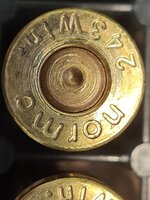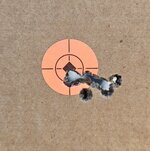wind gypsy
"DADDY"
- Joined
- Dec 30, 2014
- Messages
- 12,661
What OAL are you seating to? I’ve always used a 6” or so drop tube, is longer than that helpful?I’m using 25.4 with an 80, now that’s tight but a long drop tube makes a huge difference
Follow along with the video below to see how to install our site as a web app on your home screen.
Note: This feature may not be available in some browsers.
What OAL are you seating to? I’ve always used a 6” or so drop tube, is longer than that helpful?I’m using 25.4 with an 80, now that’s tight but a long drop tube makes a huge difference
Was disappointed in the TMKs I ordered on sale. Turns out a powder change made all the difference. Would prefer not to use Varget for the .223 as I have other intentions for it, but oh well.
Is that as high as you can go with lever? It doesn’t get entertaining until the last little bit, and I would’ve thought you could go higher than that

I would expect zero proveable difference. If some dude with a 20# benchrest rig who is capable of shooting in the 0.1s tests it, maybe they can see a difference. Run of the mill hunting rifle I'd say its very unlikely.I know I can test this all myself but I figured I would ask the question here. I read through this a while ago and have been keeping up with the updates. My question is, for a novice reloader, is there a need to get into neck tension yet? With my limited understanding, in order to control for neck tension you need the bushing dies and that's not something I have yet.
So for anyone with the first hand knowledge, what will the difference be, in group size, of ammo done with the typical RCBS dies sizing/seating vs. measuring and setting neck tension with bushings.
I'll be using RCBS dies to bump the shoulder/size. I also have access to a Lee FCD that I'm on the fence about needing, based on my research.
FWIW Its on a 300wsm and plan to load 180 gr AB. Currently, the gun is shooting Trophy Grade ammo with the 180's(Holy Crap is that expensive) at just above 2MOA(10 shot) so just trying to get below that.
Any input is welcomed.
I doubt you'd see any measurable improvement, and it would take a lot of rounds to prove it. I use standard FL dies and polish my expander down to .002-3" below bullet diameter for a little more tension on hunting ammo because it may get knocked around, and I use graphite lube in the neck to prevent bullet weld. Here is an example of how meaningless I believe things like neck tension are to a load - I had 5 loaded rounds I needed to pull to diagnose a chambering issue so I loaded them back up and shot them in this 10 shot group. I also needed to check zero because I pulled the scope bases to install recoil pins. This ammo consisted of:I know I can test this all myself but I figured I would ask the question here. I read through this a while ago and have been keeping up with the updates. My question is, for a novice reloader, is there a need to get into neck tension yet? With my limited understanding, in order to control for neck tension you need the bushing dies and that's not something I have yet.
So for anyone with the first hand knowledge, what will the difference be, in group size, of ammo done with the typical RCBS dies sizing/seating vs. measuring and setting neck tension with bushings.
I'll be using RCBS dies to bump the shoulder/size. I also have access to a Lee FCD that I'm on the fence about needing, based on my research.
FWIW Its on a 300wsm and plan to load 180 gr AB. Currently, the gun is shooting Trophy Grade ammo with the 180's(Holy Crap is that expensive) at just above 2MOA(10 shot) so just trying to get below that.
Any input is welcomed.

@West2East
I thought this video was pretty eye opening on the consistency of a Redding FL sizer vs mandrel and/or bushing dies.
I ordered a forster die today. My cheapo Lee set was giving me 0.008 runout on a lot of rounds. They usually work pretty well but I guess the RGB set is code for trash. I took the expander out and found it sizes all the way down to 0.262 from 0.276 and puts 0.0025 runout on my case neck when sizing! My groups are good, but that may be because I tweaked them straight by hand after seating and measuring. What a pain in the ass process that is. I haven't tested it but I can't imagine 0.008 runout wouldn't have an affect. Either way, my OCD isn't having that.
Forsters neck ID is 0.265-0.266, so I figured that will probably fix it and maybe I'll get it honed at some point.
Going to see if the Lee seater I have will produce acceptable results in combo with the forster FL die.
I figure I probably couldn't shoot the difference. But at least my case necks won't get worked as much
I ordered a forster die today. My cheapo Lee set was giving me 0.008 runout on a lot of rounds. They usually work pretty well but I guess the RGB set is code for trash. I took the expander out and found it sizes all the way down to 0.262 from 0.276 and puts 0.0025 runout on my case neck when sizing! My groups are good, but that may be because I tweaked them straight by hand after seating and measuring. What a pain in the ass process that is. I haven't tested it but I can't imagine 0.008 runout wouldn't have an affect. Either way, my OCD isn't having that.
Forsters neck ID is 0.265-0.266, so I figured that will probably fix it and maybe I'll get it honed at some point.
Going to see if the Lee seater I have will produce acceptable results in combo with the forster FL die.
Alpha brass has thinner necks? I was thinking of doing 0.2685 at some point based on my loaded OD of .2725I spec’d a Forster 6 creed die at .2685, ended up being too big for alpha brass but good for others.
Yes, thinner than lapua, sig, and Norma in 6 creed at leastAlpha brass has thinner necks? I was thinking of doing 0.2685 at some point based on my loaded OD of .2725
I had to drop 2 thou off the bushing I was using for lapua. Ended up using a .266 if I remember right.Alpha brass has thinner necks? I was thinking of doing 0.2685 at some point based on my loaded OD of .2725
